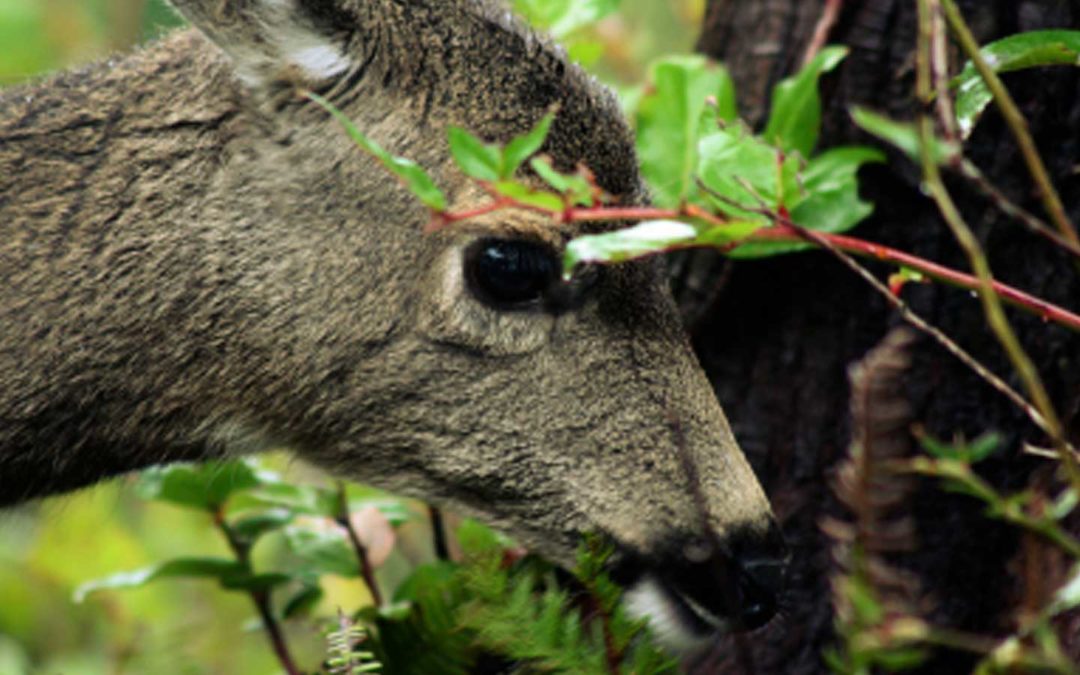It is very frustrating for gardeners when rabbits, moles, voles and deer arrive in your yard ready for a feast, assuming all the hard work you did this year was just for them.
The type of winter ahead will have an impact on the amount of animal damage, but since we have no way of predicting the weather, you must prepare for all scenarios in order to protect your investment.
Deer are browsers. They will eat out of curiosity and will try just about anything. If we receive a lot of snow, the deer will find it difficult to move around and will be more likely to show up in your yard for an easy meal. Less snow cover makes it easier for them to move around the forest grazing on acorns, grass, twigs, etc. We always recommend erring on the side of caution by preparing for both scenarios.
Rabbits have feet that are made to walk over the top of the snow, so a large snowfall allows them to reach their favorites: apple trees, and burning bush. They also like tulip buds, peas, beans, beets, and woody plants such as raspberry, cherry, plum, mountain ash, linden, maple, roses and flowering shrubs. Cut back your perennials and shrubs and remove any brush, log or junk piles that provide protective cover for many of the offending critters. Also, the presence of pet dogs and cats will often serve as an aversion to the wildlife.
Moles and voles will burrow under the snow, where we can’t see them. They feast on grass roots, leaving unsightly trails of dead grass in your yard. They can also strip back and girdle roots and trunks, and are particularly fond of fruit trees. They live next to the foundation of your home and in boulder or keystone walls where it is warm from the heat of the sun. Reducing vole habitat by mowing grass short and keeping weeds down around trees and shrubs will help.
The two major defenses gardeners have are applying repellents and exclusion. We recommend as your first line of defense, wrapping your trees to physically block their access. A good cardboard tree wrap, applied tightly starting at the base up to the first set of branches is the best thing you can do. Be sure to have it on by November 1st and remove it by April 15th. This applies to all smooth-skinned trees such as maple, fruit trees, ornamental crab apples, willow and mountain ash. When the tree is no longer smooth-skinned, you can stop wrapping it. This will occur at different stages depending on the tree. Do not use the plastic tree guards, as the animals will still be able to work their way in. Plastic tree guards are best used from April 15th to November 1st to protect against human damage such as lawn mowers and weed wackers.
Evergreens such as white pine, Norway pine, arborvitae and Taunton yews should be wrapped in burlap, not too tight, but loosely like a big diaper. You can also choose to form a box around the plant by digging in four posts and wrapping the burlap around the posts. Both these methods will also protect against winter burn. Another option is deer netting, which will allow you to still enjoy the beauty of the plant all winter, but it will not protect against winter burn.
The second line of defense is applying a repellent. There are both smell repellents and taste repellents available. They act as a training aid, as you are training them to stay out of your yard. For the best result we recommend a combination of both, and they should be applied before the first snowfall. Our products are safe for the plant, the animal, the environment and your pets, but you do have to be careful because not all products out there are safe. There are poisons you can use to kill moles and voles as well, but you must be careful if you have pets. Stop in and we can discuss your particular situation in further detail with you.
Feeding deer in another, more desirable area can also be effective. Many even say it is an enjoyable experience. They will learn to eat the food you provide, instead of your plants. Others say this just draws them in and they’ll eat your plants anyway. You’ll have to test and decide for yourself. You can also reduce damage to your landscape by growing plants which deer find unattractive. For a list of favorite and not-so-favorite plants stop in to our garden center for a free informational handout. As always, our expert staff will be happy to answer your questions.

